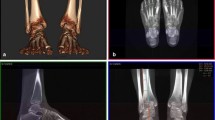Abstract
Purpose
The authors compared measurements of hindfoot alignment on MR imaging with weight-bearing CT (WB-CT) to establish the degree of correlation. Forty-seven feet in 44 patients had weight-bearing CT and MRI studies performed on the same day.
Materials and methods
Hindfoot alignment on MRI was assessed by two radiologists who calculated tibiocalcaneal angle (TCA) and calcaneofibular ligament angle (CFLA). On WB-CT, foot ankle offset (FAO), calcaneal offset (CO) and hindfoot angle (HA) were assessed by a senior Foot and Ankle Surgeon using dedicated software. Pearson correlation coefficient was used to evaluate the correlation between these measurements.
Results
The study group comprised 27 males and 17 females with a mean age of 45 years (range 13–79 years). A statistically significant positive correlation was identified between TCA on MRI and all measurements of hindfoot alignment on WB-CT (p = 0.001–0.005). The CFLA on MRI only had significant correlation with CO on WB-CT (p = 0.03). A significant negative correlation was observed between both MRI parameters (p < 0.001).
Conclusion
A highly significant correlation between tibiocalcaneal angle on non-weight-bearing ankle MR imaging and hindfoot alignment measurements on weight-bearing CT was identified.












Similar content being viewed by others
References
Büber N, Zanetti M, Frigg A, Saupe N. Assessment of hindfoot alignment using MRI and standing hindfoot alignment radiographs (Saltzman view). Skelet Radiol. 2018;47(1):19–24.
Buck FM, Hoffmann A, Mamisch-Saupe N, Farshad M, Resnick D, Espinosa N, et al. Diagnostic performance of MRI measurements to assess hindfoot malalignment. An assessment of four measurement techniques. Eur Radiol. 2013;23(9):2594–601.
Saltzman CL, El-Khoury GY. The hindfoot alignment view. Foot Ankle Int. 1995;16(9):572–6.
Reilingh ML, Beimers L, Tuijthof GJM, Stufkens SAS, Maas M, van Dijk CN. Measuring hindfoot alignment radiographically: the long axial view is more reliable than the hindfoot alignment view. Skelet Radiol. 2010 Nov;39(11):1103–8.
Richter M, Seidl B, Zech S, Hahn S. PedCAT for 3D-imaging in standing position allows for more accurate bone position (angle) measurement than radiographs or CT. Foot Ankle Surg. 2014;20(3):201–7.
de Cesar NC, Schon LC, Thawait GK, da Fonseca LF, Chinanuvathana A, Zbijewski WB, et al. Flexible adult acquired flatfoot deformity. J Bone Joint Surg Am. 2017;99A(18):e98(1)–e98(12).
Hirschmann A, Pfirrmann CWA, Klammer G, Espinosa N, Buck FM. Upright cone CT of the hindfoot: comparison of the non-weight-bearing with the upright weight-bearing position. Eur Radiol. 2014;24(3):553–8.
Burssens A, Van Herzele E, Leenders T, Clockaerts S, Buedts K, Vandeputte G, et al. Weightbearing CT in normal hindfoot alignment — presence of a constitutional valgus? Foot Ankle Surg. 2018;24(3):213–8.
Burssens ABM, Buedts K, Barg A, Vluggen E, Demey P, Saltzman CL, et al. Is lower-limb alignment associated with hindfoot deformity in the coronal plane? A weightbearing CT analysis. Clin Orthop Relat Res. 2020;478(1):154–68.
Zhang JZ, Lintz F, Bernasconi A, Zhang S. 3D biometrics for hindfoot alignment using weightbearing computed tomography. Foot Ankle Int. 2019;40(6):720–6.
Lintz F, Welck M, Bernasconi A, Thornton J, Cullen NP, Singh D, et al. 3D biometrics for hindfoot alignment using weightbearing CT. Foot Ankle Int. 2017;38(6):684–9.
Lintz F, Barton T, Millet M, Harries WJ, Hepple S, Winson IG. Ground reaction force calcaneal offset: a new measurement of hindfoot alignment. Foot Ankle Surg. 2012;18(1):9–14.
Flores DV, Gómez CM, Hernando MF, Davis MA, Pathria MN. Adult acquired flatfoot deformity: anatomy, biomechanics, staging, and imaging findings. Radiographics. 2019;39(5):1437–60.
Chhabra A, Soldatos T, Chalian M, Faridian-Aragh N, Fritz J, Fayad LM, et al. 3-Tesla Magnetic resonance imaging evaluation of posterior tibial tendon dysfunction with relevance to clinical staging. J Foot Ankle Surg. 2011;50:320–8.
Lee S, Oliveira I, Pressney I, Welck M, Saifuddin A. The horizontal calcaneofibular ligament: a sign of hindfoot valgus on ankle MRI. Skelet Radiol. 2019;49(5):739–46.
Portney L, Watkins M. Foundations of clinical research: applications to practice. 3rd ed. Upper Saddle River: Pearson/Prentice Hall; 2009.
Abousayed MM, Alley MC, Shakked R, Rosenbaum AJ. Adult-acquired flatfoot deformity: etiology, diagnosis, and management. JBJS Rev. 2017;5(8):e7.
Henry JK, Shakked R, Ellis SJ. Adult-acquired flatfoot deformity. Foot Ankle Orthop. 2019;4(1):1–17.
Yao K, Yang TX, Yew WP. Posterior tibialis tendon dysfunction: overview of evaluation and management. Orthopedics. 2015;38(6):385–91.
Bruno F, Barile A, Arrigoni F, Laporta A, Russo A, Carotti M, et al. Weight-bearing MRI of the knee: a review of advantages and limits. Acta Biomed. 2018;89:78–88.
Acknowledgments
We would like to thank Mr. Paul Bassett and Mr. Karan Malhotra, Locum Foot and Ankle Consultant Surgeon, for their valuable help with some of the statistical analyses in this research work.
Author information
Authors and Affiliations
Corresponding author
Additional information
Publisher’s note
Springer Nature remains neutral with regard to jurisdictional claims in published maps and institutional affiliations.
Rights and permissions
About this article
Cite this article
Haldar, A., Bernasconi, A., Junaid, S.E. et al. 3D imaging for hindfoot alignment assessment: a comparative study between non-weight-bearing MRI and weight-bearing CT. Skeletal Radiol 50, 179–188 (2021). https://doi.org/10.1007/s00256-020-03532-7
Received:
Revised:
Accepted:
Published:
Issue Date:
DOI: https://doi.org/10.1007/s00256-020-03532-7




